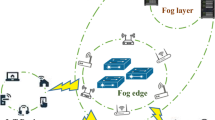Abstract
With the growing number of its students, Virtual University of Senegal is often faced with a lack of quality of service during synchronous learning activities. Thus, the University has set itself the challenge of reinforcing its technological device to make it even more robust in order to support the increasing number of students with a more powerful infrastructure. In this perspective, we have, in this paper, proposed an online teaching platform based on fog computing. Thus, we have proposed an optimal placement of educational resources at the fog layer nodes in order to relieve the backbone network and, consequently, reduce the response time of students’ requests during synchronous activities, which are very sensitive to delay.
Access this chapter
Tax calculation will be finalised at checkout
Purchases are for personal use only
Similar content being viewed by others
References
Rana Lone, C.P., Ahmad, Z., Ajay.: Architecture du système d’apprentissage en ligne pour le cloud computing - un examen
Gueye, S.M., Diop, A., Gueye, A.D.: A machine learning model on virtual university of senegal’s educational data based on lambda architecture. In: 2020 7th International Conference on Electrical Engineering, Computer Sciences and Informatics (EECSI), pp. 270–275. IEEE (2020)
OpenFog Consortium Architecture Working Group et al.: Openfog reference architecture for fog computing. OPFRA001 20817 162 (2017)
Pecori, R.: Augmenting quality of experience in distance learning using fog computing. IEEE Internet Comput. 23(5), 49–58 (2019)
Pecori, R.: A virtual learning architecture enhanced by fog computing and big data streams. Future Internet 10(1), 4 (2018)
Amor, A.B., Abid, M., Meddeb, A.: Secure fog-based e-learning scheme. IEEE Access 8, 31920–31933 (2020)
Khairy, D., Amasha, M.A., Abougalala, R.A., Alkhalaf, S., Areed, M.F.: A security system for e-exams using an IoT and fog computing environment. J. Theor. Appl. Inf. Technol. 100(2), (2022)
Ibrahim, T.S., Saleh, A.I., Elgaml, N., Abdelsalam, M.M.: A fog based recommendation system for promoting the performance of e-learning environments. Comput. Electr. Eng. 87, 106791 (2020)
Sood, S.K., Rawat, K.S.: Fog-assisted virtual reality-based learning framework to control panic. Expert Syst. 39(4), e12700 (2022)
Mseddi, A., Jaafar, W., Elbiaze, H., Ajib, W.: Joint container placement and task provisioning in dynamic fog computing. IEEE Internet Things J. PP(99), 1 (2019)
Ross, S., Terry, G., Richard, M.: A branch and bound algorithm for the generalized assignment problem. Mathe. Program. 8(1), 91–103 (1975)
Hochba, D.S.: Approximation algorithms for NP-hard problems. ACM Sigact News 28(2), 40–52 (1997)
Cormen, T.H, Leiserson, C.E., Rivest, R.L., Stein, C.: Introduction to algorithms. MIT press, Cambridge (2009)
Author information
Authors and Affiliations
Corresponding author
Editor information
Editors and Affiliations
Rights and permissions
Copyright information
© 2022 ICST Institute for Computer Sciences, Social Informatics and Telecommunications Engineering
About this paper
Cite this paper
Gueye, S.M., Diop, A., Gueye, A.D. (2022). Towards an Optimal Placement of Learning Resources in a Fog Computing Based E-Learning System: The Case of UVS. In: Mambo, A.D., Gueye, A., Bassioni, G. (eds) Innovations and Interdisciplinary Solutions for Underserved Areas. InterSol 2022. Lecture Notes of the Institute for Computer Sciences, Social Informatics and Telecommunications Engineering, vol 449. Springer, Cham. https://doi.org/10.1007/978-3-031-23116-2_26
Download citation
DOI: https://doi.org/10.1007/978-3-031-23116-2_26
Published:
Publisher Name: Springer, Cham
Print ISBN: 978-3-031-23115-5
Online ISBN: 978-3-031-23116-2
eBook Packages: Computer ScienceComputer Science (R0)




